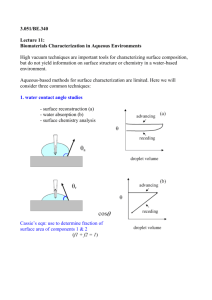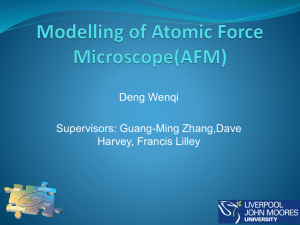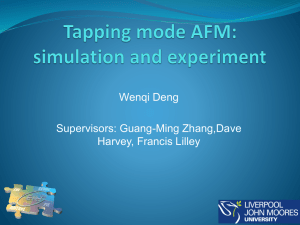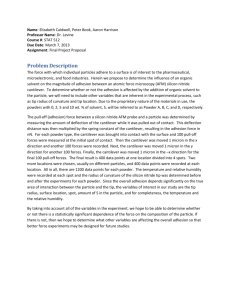How Do Scientists Know What They Know? The Atomic Force Microscope
advertisement
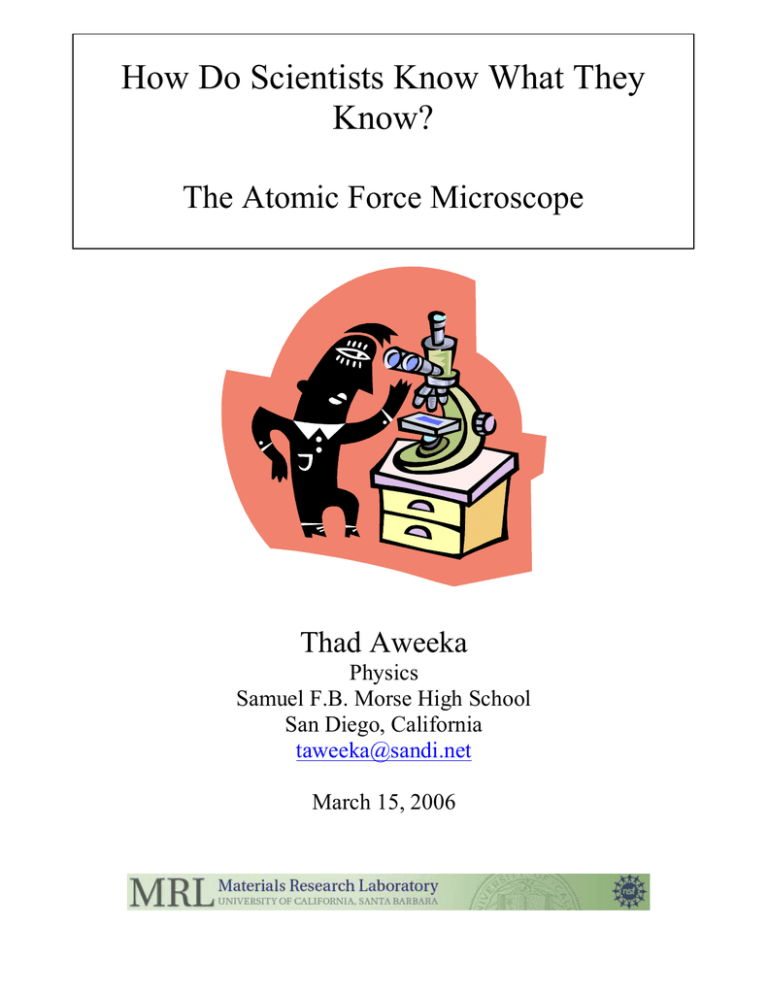
How Do Scientists Know What They Know? The Atomic Force Microscope Thad Aweeka Physics Samuel F.B. Morse High School San Diego, California taweeka@sandi.net March 15, 2006 FORCES and SPRING-CONSTANTS In this activity, you will be investigating the spring-constants of different cantilevers by hanging known masses, thus knowing the weight or force due to gravity, off the ends of cantilevers, exerting forces on the cantilever. You will then be able to calculate the spring-constant of a particular cantilever by measuring the vertical displacements and fitting the data to a best-fit slope, discovering the simple linear relationship, F=kx. 1. Carefully clamp a cantilever into position as shown in the diagram. Use different masses to make a scale of measurements to “calibrate” the cantilever. The force you are using to calibrate the meter is gravity, the force with which Earth pulls downward on every object near its surface. 2. Draw a line on a piece of paper. Hold the paper next to the plastic strip so that the line is even with the edge of the strip. Mark the position of the end of the strip on the reference line and label the position as the “zero” mark. 3. Hang one mass on the strip near the strip’s outside end. Notice that the strip bends downward and then stops. Hold the paper in the original position, mark the new position of the end of the strip, and label the mark according to the mass. 4. Repeat step 3 for twice, three-times, and four-times the mass originally hung from the strip. In each case mark and label the new position of the end of the strip. 5. Plot the Weight (or Force) on the y-axis and the displacement on the x-axis. 6. Use a ruler to draw a best-fit, straight line of your four data points. 7. Choose two other cantilevers and repeat steps 3 thru 6, two more times. 8. Do all the cantilevers exhibit Hooke’s Law’s “straight-line” relationship, Force = k displacement? If not, should you have chosen different masses for one or more of your cantilevers? MAPPING A MAGNET Activity Materials Refrigerator magnet with removable probe strip Magnetic field diagrams Starting Points One of the great breakthroughs in the field of nanotechnology was the ability to image individual atoms. We “see” the individual atoms that make up the nanoworld using instruments called scanning probe microscopes (SPMs) of which the atomic force microscope (AFM) is included. These instruments use a probe tip that can terminate down to a single atom. When the probe strip is scanned across a surface in atom-sized movements, differences in force can be felt by the probe tip as it is closer or farther away from the surface atoms. Researchers use this method to image the pattern of atoms on the surface. Activity Procedure To demonstrate how atoms are “seen”, remove the labeled “probe strip” from your refrigerator magnet by tearing it along the perforation. Now, drag the probe strip along the dark unprinted side of the magnet in the two perpendicular directions as shown in the examples below. QuickTime™ and a TIFF (Uncompressed) decompressor are needed to see this picture. QuickTime™ and a TIFF (Uncompressed) decompressor are needed to see this picture. Based on what you feel, which of the three diagrams below best represents how the magnetic field is arranged? Does it feel like choice A – a completely uniform arrangement, does it feel like choice B – alternating stripes, or does it feel more like choice C – alternating in both directions like a checkerboard? QuickTime™ and a TIFF (Uncompressed) decompressor are needed to see this picture. QuickTime™ and a TIFF (Uncompressed) decompressor are needed to see this picture. A B QuickTime™ and a TIFF (Uncompressed) decompressor are needed to see this picture. C If you said choice B, you are correct! The way a scanning probe microscope works is very similar to the experiment we just did. If the probe strip was sharpened to a single atom, and you could move it atom by atom across the surface and feel the differences in forces, then you would have an SPM! AFM, Cantilever with Tip, Sample Damage Your group is to assemble the cantilever and tip portion of an Atomic Force Microscope. Each group will choose two items from each of the following categories and assemble them in different combinations: Various plastic cantilevers with varying spring-constants (stiffness.) Nail, pyramid, or broadly-rounded tip. Scan the clay sphere in “contact-mode” using at least two different cantilever-tip combinations. Post-Activity Questions 1. Which type of tip caused more damage to the sample? How do you know this? 2. Which type of cantilever caused more damage to the sample? Was it the cantilever with the larger spring-constant, ‘k’? Was it the cantilever with the smaller spring-constant, ‘k’? And how do you know this? 3. Based on what you learned here and in a previous activity and assuming an equal deflection of the cantilever in both cases, which cantilever exerts more force on the sample, a cantilever with a large ‘k’ or one with a small ‘k’? 4. Assume you use the same cantilever to scan the sample in two cases (the force exerted by the cantilever is the same in both cases as well,) one with a nail tip and one with a broad tip. Why does one type of tip impart more damage? Do you think it has something to do with the surface-area of the end of the tip? Why or why not? AFM, Cantilever with Tip, Accuracy Your group is to assemble the cantilever and tip portion of an Atomic Force Microscope. We will be using a standard cantilever (popsicle-stick) and varying the size of the tip using a nail and different sized Styrofoam balls. Instead of laser light, you will be “imaging” the sample with a pen or pencil that extends off of the cantilever and is recorded on the vertical-paper. In this activity, we will be looking at the size of tips and how it relates to the accuracy of the images. 1. Attach a nail, or small, medium, or large styrofoam ball to the end of the cantilever. This will serve as your tip. 2. Glue (or secure in some other way) the imager (pen or pencil) to the cantilever. 3. As you “scan” the sample, keep the end of the tip against the sample and the pen or pencil against the paper. 4. Image a cross-section (length or width) of a sample sphere. 5. Repeat steps 1-4 using a sample cube. 6. Repeat steps 1-5 using a different size tip. Post-Activity Questions 1. How did the size of the sphere image vary with tip size? 2. How did the vertical profile of the cube vary with tip size? 3. Is there a correlation between tip size and imaging accuracy? 4. Which size-tip gave the more accurate image? 1. a. On a separate sheet of paper, sketch and describe each image for the given image widths below at the following web-site: http://micro.magnet.fsu.edu/primer/java/scienceopticsu/ powersof10/index.html (Image widths: 10-6, 10-3, 10-2, 10-1, 100, 10+1, 10+2, 10+3, 10+6, 10+8, 10+13, 10+15, and 10+22 meters.) b. Google Maps Go to Google.com Click on “More” Click on Maps Search: San Diego Find Morse High School Click: Satellite (Find Room 504 and the Library) Zoom in as far as possible on Morse On a separate sheet of paper, sketch the scene/objects in the satellite image (photograph.) 1. Go onto the internet and do a search on the Atomic Force Microscope (AFM.) Write a one-page rough-draft report on a) How does the AFM work? And b) What are the advantages and disadvantages for a scientist using an AFM? The following two websites will get you started. http://stm2.nrl.navy.mil/how-afm/how-afm.html http://spm.phy.bris.ac.uk/techniques/AFM/ 2. Choose five AFM images from the following web-sites and sketch and describe them. http://www.jpk.com/spm/gallery1.htm http://www.jpk.com/index.htm RET I Project Tau is one of many microtubule associated proteins (MAPs) thought to play an important structural and functional role in the make-up of microtubules in eukaryotic cells, bundled microtubules making up the axons of neurons, and tau-to-tau interactions are likely to play an important role in microtubule structure and arrangement during normal neuronal development. However, tau aggregations present a molecular mechanism for tau-mediated cell death, one leading hypothesis being that it is the accumulation of defective tau proteins which sequester MAPs from performing their function. During my six-week research project, my mentor and I attempted to look at how tau binds to mica slides and how tau binds to other tau on mica using an Atomic Force Microscope (AFM) and cantilever with a nanoscaled tip in an aqueous environment. RET II Project Utilizing the AFM in my research led me to create a unit incorporating scientific notation, accuracy, size and scale, microscopy, and forces. Students investigate animation and images as pertains to the relative size of objects and the Powers of Ten. Students investigate different types of AFM images and their dimensions. Students use the internet and the teacher’s input to investigate the basic operation of the AFM. Students “map” the magnetic field of a refrigerator magnet using a magnetic strip and the teacher’s guidance (Magnetic AFM.) Students investigate and calculate Hooke’s Law spring-constants for different types of cantilevers (by hanging masses off the ends and measuring the vertical displacement.) Students assemble tips to cantilevers and investigate the damage imparted by each to clay samples. Students discover how the accuracy and feasibility of imaging a given sample relates to the size of the tip. Standards/Students Objectives Activities Powers of Ten California and National Content Standards Students will understand the relative size of objects down to elementary particles. [Nat’l. Content Std. Physical Science (9-12) p. 178] AFM images Scientists rely on technology to enhance the gathering of data. The accuracy and precision of the data depends on the technology used. [Nat’l Content Std. Science as Inquiry (9-12) p. 176] Forces (or weights) and cantilever spring-constants. Laws of motion are used to calculate precisely the effects of forces on the motion of objects. The magnitude of the change in motion can be calculated using the relationship F=ma, which is independent of the nature of the force. [Nat’l. Content Std. Physical Science (9-12) p. 179, 180] Various cantilever and tip assemblies versus sample damage. Pressure = Force / Area [Proposed.] Various tip sizes versus sample image. Students will identify and communicate sources of unavoidable experimental error. [Ca. Content Std. Investigation and Experimentation (9-12) 1.b.]


